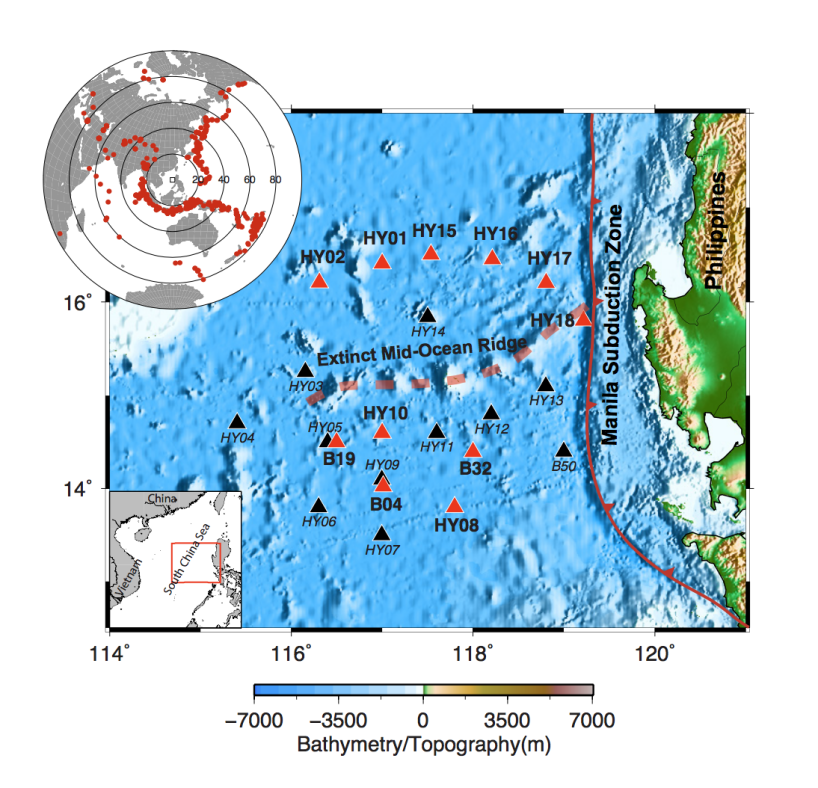Recently, Professor Ting Yang’s group at the Department of Marine Science and Engineering of Southern University of Science and Technology have made significant progress in the tectonic evolution of the South China Sea (SCS). They revealed the patterns of crustal accretion and magmatism of the SCS mid-ocean ridge before its closure based on seafloor seismic observations. The article, entitled “Crustal structure across the extinct mid-ocean ridge in South China Sea from OBS receiver functions: insights into the spreading rate and magma supply prior to the ridge cessation” has been published in Geophysical Research Letters, the top natural index journal in the field of Geoscience.

Figure 1. OBS stations (red) and global earthquakes (inset) used in this study.

Figure 2. The thickness of the oceanic crust at the OBS station in the South China Sea plotted against the distance from the extinct ridge. At sites near the ridge, the thicknesses of the oceanic crust are anomalously thinner, indicating the magma supply to generate oceanic crust significantly decreases.
The spreading ridge of an ocean basin is where the magma gushes from the earth’s interior, and the new oceanic crust forms. Everything has a life cycle, and the Mid-ocean ridges are no exception. They can both form and die. For example, about 15 million years ago, the ridge in the SCS gradually slowed down from an active mode until it was closed entirely. What happens to the crustal accretion and the melt generation along the ridge axis as a ridge dies? These are the frontier scientific questions in the field of marine geophysics. Prof. Yang’s group explore a well-known extinct spreading center within the SCS. Using ocean bottom seismometers and the receiver function technique, they determine the thickness of the magmatic crust and a parameter (Vp/Vs) that reflects the underlying crust structure. They find that, approaching the extinct spreading axis, the crust, typically uniforms in thickness, thins significantly. This indicates that the melt supply decreases relatively to the spreading rate during the final stages of spreading. The Vp/Vs ratio at three sites nearest to the extinct spreading axis is abnormally high. Their explanation is that the spreading rate and magma production has decreased to the point where large crustal faults can develop at several locations along the ridge. These faults provide seawater pathways to reach and react with the uppermost mantle, forming minerals with higher Vp/Vs ratios that are then uplifted to the seafloor as the faults grow.
This research result has not only revealed the SCS tectonic evolution but also is of significance for understanding the magmatic process of the global mid-ocean ridge system.

Figure 3. The Vp/Vs ratio of the oceanic crust at the OBS station. At three stations south of the ridge, the ratios are abnormally high, indicating that their crust or upper mantle has undergone strong hydration.
The first author of the paper is Dr. Tran Danh Hung, a visiting student of SUSTech. Prof. Yang is the corresponding author. Other co-authors include postdoctoral fellows Ba Manh Le and Jian Wang of SUSTech, Dr. Mei Xue and Dr. Youqiang Yu from Tongji University, Prof. Baohua Liu and Dr. Chenguang Liu of the First Institute of Oceanography, PhD student Pan Mohan of SUSTech, Liu Fang of Shanghai Sheshan Geophysical Observatory, and Prof. Jason P. Morgan of SUSTech. This research was supported by the National Natural Science Foundation of China and the Shenzhen Municipal Science and Technology Innovation Commission.
Article link: https://agupubs.onlinelibrary.wiley.com/doi/10.1029/2020GL089755
Proofread ByZhong YANG, Yingying XIA
Photo By